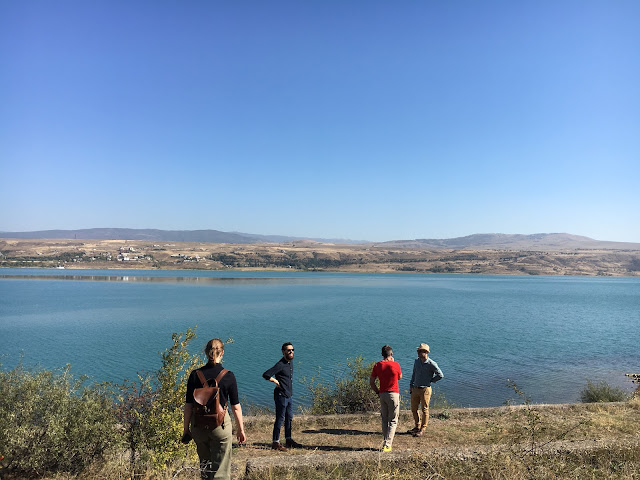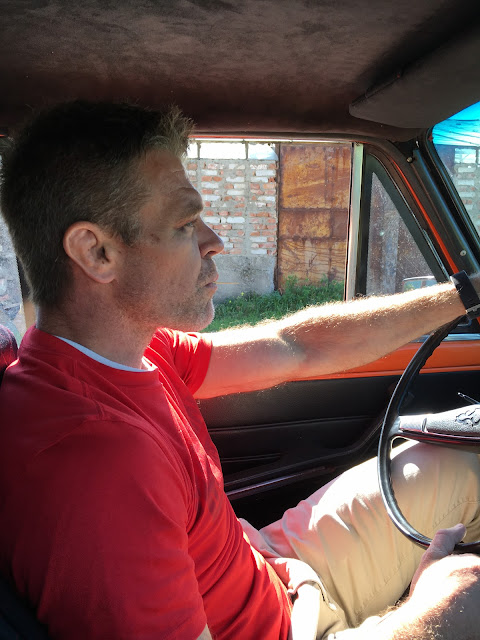One day early in the week, Will was training and gave me the reins on planning our free time. I spent some time looking around at tours. I booked the city bus tour and the old capital tour. Then I found this super cool tour called Concrete Giants. It promised to take us around the city of Tbilisi to all of the monuments and crazy buildings, complete with explanations of their history. It was exactly what we wanted to do! We had spent several days driving to and from the sports palace and our hotel, passing decrepit looking apartment buildings, statues, and plain old weird buildings. We couldn't get any information on how or why anything was built. This tour promised to be the answer to all of our questions.
Monday morning we met our guide, David. We took the tour with another couple, Amelia and Ben, from New York City. We met at a sculpture of a gigantic bike. It was supposed to be an homage to getting out and exploring the city and nature. But people ended up hating it and started vandalizing it. We thought it was cool!
David took us around in an old Soviet era car, bright orange! We started learning about the various apartment buildings. We learned that most of the buildings were built in specific styles depending on who was in charge of the Soviet Union. Additionally, the buildings were built by people who could produce the biggest bribes, not those who could produce high quality, safe work. Permits were green lighted based on who you knew or who you could bribe. There was almost no city planing or structure. If you had money and connections you could build a building. People who moved into apartments owned the individual apartments but no one seemed to own the building. Families, when they needed some more space would build out into the balconies. They would just add concrete blocks to the balcony, safety and building codes not required. They would call the new rooms suicide rooms because they were not super safe.
You can see and example in the building below of a suicide room. The balconies on the right, the top one is still and open balcony. The two below it are blocked in to create indoor living space. Even today, with the Georgian government, no one seems to own the whole building. The residents own their individual apartments. When there is a problem in the building, someone takes on the responsibility of raising money and hiring a contractor to fix the problem. As a result, the exterior of all the buildings look awful, but the interior is fine. It was so interesting to learn!

Our next stop was a HUGE monument called the Chronicles of Georgia. It was constructed in the 1970's and finished in the 80's by one of Georgia's famous artists. It is so huge. Each wall is made of bronze panels. The bottom layers depict the life, scenes and stories of Christ. The middle panels are of Georgia's Kings, poets, and educators. The top panels honored the everyday Georgian citizen with sculptures of various social activities and industries. The whole thing was so impressive!
You can see an example of the panels showing Christ's life behind me in the picture below.
In this picture you can better see all three layers and make out the scenes of Christ's life at the bottom, the individual Kings, poets, etc. in the middle, but you can't really see the Georgian social panels on top.


Our next stop was the scariest and most fascinating! There are four different tribes of people in Georgia, or maybe there were...I can't quite remember. They each speak a different dialect and have different cultures, traditions etc. About 30 years ago some of these tribes were warring. It resulted in one tribe becoming refugees in their area. The government decided to give these displaced people a place to live. They turned over two large (and abandoned) hotels at the edge of a reservoir. The hotels were meant to be luxury resorts but the projects had been abandoned. So the government gave the abandoned hotels to the refugees. It was intended to be a short term solution but so far, the refugees have stayed in the hotels. Each family has a hotel room to live in with a on suite bathroom. They cook on hot plates and collect a government pension.
David, our tour guide, has ancestors who are people from these tribes. He speaks the dialect and was able to take us up into the hotel. We passed people's rooms with the doors open. We passed piles of discarded stuff. We climbed all the way up to the top of the building to see the view.
At the hotel we were also able to see some examples of Georgian mosaic art. The mosaics were first made by the same artist who made the Chronicles of Georgia. However, lots of people started mimicking his art using cheaper materials. Then people started vandalizing his finer creations. You can see some of the smashed glass tiles in the picture with me in it.
On the way back from the hotels David gave anyone who wanted a turn to drive his old car. Will quickly volunteered. He said it was very similar to his first car, a very old Toyota.
Our next stop was the archaeology museum. Actually, it is a storage facility for the archaeology museum. Students and researchers come here to study artifacts that are not on display in the museum. The building was first intended to be three buildings and used as part of a water storage system. That project was abandoned after just one building was finished. Many years later the archaeology museum took the building over for storage. The artist who created the large sculpture on the front of the building created it in honor of his wife, who had recently died of cancer. He created her image curled up and paid further honor to local jewelry making trades with the style of jewelry the figure is wearing.

Near the archaeology museum is a statue of Saint Nino, the woman who brought Christianity to Georgia. David called her "Raving Saint Nino" because it looks like she is DJing at a rave. It was funny. Also, Saint Nino is usually depicted with this specific cross that she made on her way to Georgia. She wanted to pray and so made a cross out of grape vines and tied it with her hair.
This is the view from the Saint Nino statue. A little slice of some of Georgia's buildings.
We drove past this building and statue almost every day we went to the sports palace. The building used to be a power control station in Soviet times but now is a radio station. The statue is of a tiger and a man fighting. The artist created this statue to honor mothers. Because while the tiger and man are fighting their mothers have the same prayer: that their child will be victorious.
This was the building we had been the most curious to learn about! We passed it several times in our travels and could not figure out what was going on inside, who would have designed it that way, and what was going on in any way. It looks like a giant was playing jenga with shipping containers and got interrupted mid game.
Turns out this building now houses a private bank. However, when it was built it was built for the Ministry of high way construction. Each block was intended to be a different department in the ministry. The building was abandoned until 2011 when the bank bought the building and renovated the interior. I guess the elevators are the hardest thing to figure out?
We stopped for dinner at a little cafe. David helped us order lots of traditional food. My favorite was a polenta type dish with a curry type sauce on top. Everything was delicious but I didn't take any pictures.
After lunch we toured a building that was again designed and decorated on the exterior by the same artist who did the Chronicles of Georgia and mosaic tiles. This building has been the Palace of Culture under Soviet rule. The building produced propaganda and also provided kids activities like art and dance classes. When Soviet rule ended Georgia kept the kids dance and activities in the building. In 2005 the building was sold and going to be destroyed. The owners started tearing down the front and building a parking structure. The parents and children protested and got the destruction/construction stopped. Now the building is in half stages but still used for dance and creative pursuits for kids. Hey, I just found the name of the artist in my notes! Zurab Tsereteli...google it.
The inside of the building was so cool! The glass mosaics were beautiful. David said you could smell the Soviet Union inside the building. It smelled like oil, wood and maybe mothballs? It was weird and fun.
Last stop! This was quite wild. These three buildings had been built for factory workers for a near by factory. The buildings were built and the units sold...and then the exterior was abandoned. So, no one owns or cares for the exterior of the building. These buildings are also interesting because of the walkway. The builders put the buildings up a hill. There isn't a main road that goes up to the second and third building. So the designers put one elevator in each building that only goes from the ground floor up to the 14th where the walkway is. So people (anyone, not just residents) can enter the building and take one elevator up to the 14th floor and cross on the walkways to the other buildings or the other neighborhoods behind this building. Crazy and brilliant!
This poster is an example of what the apartments look like inside. You can see they are renovated and well cared for...but you'd never guess based on the outside!
Here is David in his old car. It was really such a fantastic tour! Both Will and I LOVED it.
Of course we walked up and took the walkways across...it was terrifying.
High quality, informative, and SO MUCH FUN! We can't recommend the Concrete Giants tour enough. Next time you are in Tbilisi, Georgia...check it out.























































